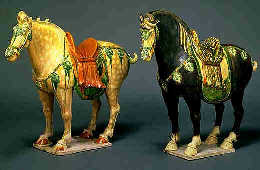| Art Q&A > Crafts |
|
Tang Tri-colored Glazed Pottery A
type of glazed pottery with the dominant colors of yellow, brown and green was
very popular in the Tang Dynasty (618-907). It was later called the tri-colored
glazed pottery of the Tang Dynasty, or Tangsancai
. A
type of glazed pottery with the dominant colors of yellow, brown and green was
very popular in the Tang Dynasty (618-907). It was later called the tri-colored
glazed pottery of the Tang Dynasty, or Tangsancai
.
The Tang tri-colored glazed pottery is a low-melting glazed pottery. It was made by adding metallic oxides to the colored glaze and calcining the object to create different colors, namely the predominant yellow, brown and green. The chemicals in the glaze change gradually in the firing process, creating a variegated effect with a majestic and elegant artistic attraction. Tri-colored glazed pottery was usually used as burial objects. Its loose and brittle base and its low waterproofing properties meant it was not as practical as the blue and white porcelain that had already emerged at the time. Tri-colored glazed pottery utensils of the Tang were usually rounded and full in shape in accordance with the aesthetic values of the time. The accurately proportioned human and animal figures have fluid lines, natural expressions and life-like movements. The soldier figures have strong muscles, big staring eyes and wield swords or arrows. The female figures have high hair buns and full sleeves; they stand gracefully erect, looking natural and elegant. The animal figures are mainly of horses and camels. A tri-colored glazed pottery of a camel and a dance group was unearthed in a Tang general's tomb. The camel is brown and stands with its head raised high. The long hairs on its head, chest, stomach and upper parts of its two front legs were carefully executed. On the camel's back is a platform covered by a rug with two ethnic musicians seated on it with their backs to each other playing instruments. A third ethnic person dances between them. The three human figures have deep eyes, high-bridged noses and full beards; they are wearing long, green sweaters with turned-down collars and white boots. The figure in the front has a deep yellow coat. This piece of pottery is truly an exquisite handicraft. Tri-colored glazed pottery of the Tang Dynasty was mostly produced in Xi'an, Luoyang and Yangzhou, which were important cities along the Silk Road. The camel was the major form of transport on the ancient trade route during the Tang. From these gazed potteries, we can imagine the travelers and camels making their hard journey across the desert, depending on one another for survival. The large figures and camels' resolute expressions represent the hardships associated with traveling on the long road. Tri-colored glazed pottery is the crest of Tang pottery and it flourished during the dynasty's early and middle period. As the Tang gradually lost power and its porcelain-producing technology developed, tri-colored glazed pottery declined. Though tri-colored glazed pottery was also produced during the Liao (916-1125) and Jin (1115-1234) dynasties, it was not made in such great quantity and its quality was not as good as that of the Tang. Tri-colored glazed pottery was exported to foreign countries in the early Tang, winning great favor. It was always been famed for its bright colors and pleasing shapes. Tri-colored glazed pottery of the Tang Dynasty is a shining pearl among ancient Chinese pottery. As the tri-colored glazed pottery continued to improve through the centuries,
now it has been developed even further and its varieties number several hundred.
The once tri-colour glaze has expanded to include yellow, purple, black and blue
and its artistic quality has also soared. |
||
All rights reserved. Reproduction of text for non-commercial purposes is permitted provided that both the source and author are acknowledged and a notifying email is sent to us. |
||
 |